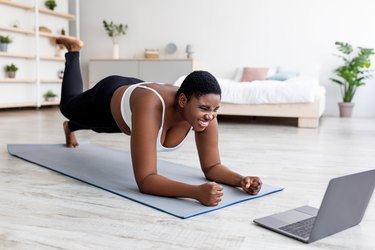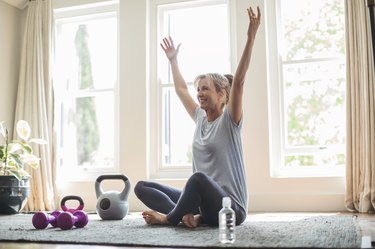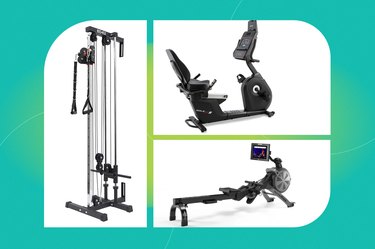
When you're living with arthritis, physical activity can feel like a catch-22: Gentle exercises like yoga are beneficial, but some moves may feel off-limits due to pain.
But rest assured, even if your joints are achy, you can still practice yoga and reap the benefits. Here's what you need to know about arthritis, the benefits of yoga and how to practice in a way to prevent injury.
Video of the Day
What Is Arthritis?
Overall, arthritis describes more than 100 conditions that affect your joints, tissues around your joints and other connective tissues, per the U.S. Centers for Disease Control and Prevention (CDC).
"Arthritis is a condition that causes inflammation and pain within joints," says Bhakti Shah, MD, a rheumatologist at Crystal Run Healthcare in New York. "There are various forms of arthritis, with the most common being osteoarthritis, which is a degenerative process that occurs due to wear and tear on the joints. This can result in pain and limited mobility for patients."
Other types of arthritis include rheumatoid arthritis (an autoimmune and inflammatory disease) and gout (a painful type of arthritis that typically affects the big toe).
Pain from arthritis may discourage you from moving, but exercise is crucial for managing symptoms.
"In general, consistent movement is key," Dr. Shah says. "A sedentary lifestyle is the greatest risk factor in limiting quality of life in patients with arthritis. Moderate physical activity of about 150 minutes per week is not just great for arthritis, but also for preserving cardioprotective health."
(It's worth noting early half of all adults with heart disease also have arthritis — and inflammatory forms of arthritis like rheumatoid arthritis increase your risk of heart disease, per the Arthritis Foundation.)
How Can Yoga Help Arthritis?
Eight weeks of yoga classes improved the physical and mental well-being of sedentary adults with two common forms of arthritis, knee osteoarthritis and rheumatoid arthritis, according to a July 2015 study published in The Journal of Rheumatology.
"Yoga is beneficial for arthritis, as it focuses on toning and strengthening, while improving flexibility and balance," Dr. Shah says. "Yoga also encourages relaxation and stress reduction, which can help to improve overall mood and promote more physical and mental well-being."
Yoga is low-impact, so it places less direct force on your back, hips and knees compared to certain types of aerobic activity. When you have arthritis, it's often challenging to reverse structural joint changes that have already occurred. Because of that, the focus of physical activity is geared toward strengthening the muscles that support the joints, Dr. Shah adds.
Plus, the mental health benefits of yoga for those living with chronic pain cannot be ignored. Yoga increases pain tolerance, decreases pain unpleasantness and lowers anxiety and distress associated with pain, per a June 2019 research review in Complementary Therapies in Medicine.
"The breathing practices, the mindfulness meditation and relaxation in yoga can change pain processing," says certified yoga therapist Steffany Moonaz, C-IAYT, E-RYT 500, founder and director of Yoga for Arthritis. "I like to say that meditation is the most important yoga practice for people with arthritis because pain is in the nervous system — it's not in the joints."
That said, not all yoga poses may be accessible if you have arthritis. It's important to approach the practice in a way that works for your body, while modifying or skipping certain moves as necessary. A yoga practice can be harmful for people with arthritis if it's not carefully executed or designed for people who have joint disease.
"It's important for people who are living with arthritis to find an appropriate instructor and practices that are right for them," Moonaz says. "That being said, yoga can be incredibly beneficial when it's executed appropriately."
The 5 Best Yoga Poses for People With Arthritis
Yoga can be adapted for the needs and abilities of any person. Here are five moves Moonaz recommends for people with arthritis.
Tip
When it comes to yoga for arthritis, there are no rules for how long you should practice or repeat certain poses. These moves should be done to comfort, which will differ based on your body and condition. If anything feels painful, stop to rest your joints and contact your doctor with any questions or concerns.
1. Dynamic Side Stretch
- Sitting upright with your arms at your sides, take a deep inhale and lift your left arm out to the side and up as high as feels comfortable and available.
- On an exhale, reach over to the right, keeping both hips on the chair and stretching the whole left side of your torso.
- Inhale and return to the upright starting position.
- Exhale and lower your left arm down.
- Repeat this on the other side. This can be done several times to reduce tension in your back and improve your posture, which allows for easier breathing and less discomfort.
Tip
If you have more range of motion on one side than the other in your shoulder or spine, it's okay to go farther in one direction and keep the other side’s movement smaller.
2. Deep Breathing
- Sitting or standing upright, place your right hand on your abdomen and your left hand on your chest.
- Take a deep breath in, allowing your whole torso to expand. Purse your lips, keeping the rest of your face relaxed.
- Let the breath out very slowly, like blowing through a straw.
- Repeat as desired.
Tip
This slow exhale affects your nervous system and can reduce your pain response, Moonaz says. This can be particularly helpful if you're feeling stressed or overwhelmed.
3. Hand Mobilization
- Sitting or standing, extend your hands in front of you.
- Wiggle your fingers, then open and close your hands.
- Bring each finger toward your thumb, one at a time.
- Shake your hands out and let them rest. This reduces stiffness in your hands.
- Repeat as desired.
Tip
It's important to find the balance between enough movement and too much. If this becomes uncomfortable or you feel pain in your hands, stop and massage them a little bit. This can be used as a break from typing or other repetitive movements, or if your hands feel stiff after inactivity.
4. Knee Stabilization
- Sit in a chair with your feet planted firmly on the floor.
- Hold the sides of the chair for stability or let your hands rest in your lap.
- Take a deep breath in, and on the exhale, extend your right leg forward, toes pointed up.
- On an inhale, lower your leg back down.
- Repeat with your left leg.
Tip
You can do this several times on each side to help strengthen major muscles that stabilize your knee joint, which can help to delay arthritis progression. For a greater challenge, keep your leg extended for a few breaths, or even try extending both legs together, as long as you can continue sitting up tall. The height of the leg is unimportant, as long as you're engaging the thigh muscles of each leg.
5. Progressive Relaxation
- Sit in a chair with your feet planted firmly on the floor.
- Hold the sides of the chair for stability or let your hands rest in your lap.
- Lift both feet a few inches off the floor floor and tense all the muscles of your legs.
- Lower your feet to the ground and let your legs relax.
- Extend your arms and squeeze all of your arm muscles, including your hands. Then let them rest and relax.
- Draw your abdomen in and squeeze all the muscles in your torso like a corset. Then take a deep breath in and out, allowing your abdomen to expand and relax.
- Squeeze the muscles of your face tight, then allow them to relax.
- Spend a few moments allowing your body to rest and relax.
Tip
It may seem counterintuitive, but tensing your body can actually make relaxation more available. Some people hold tension in their body that can make pain worse. Try this when you notice stress or tension in your body.
- CDC: "Arthritis Types"
- Arthritis Foundation: "Arthritis and Heart Disease"
- Complementary Therapies in Medicine: "What are the known effects of yoga on the brain in relation to motor performances, body awareness and pain? A narrative review"
- The Journal of Rheumatology: "Yoga in Sedentary Adults with Arthritis: Effects of a Randomized Controlled Pragmatic Trial"




